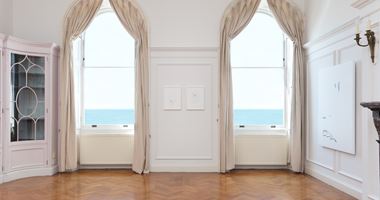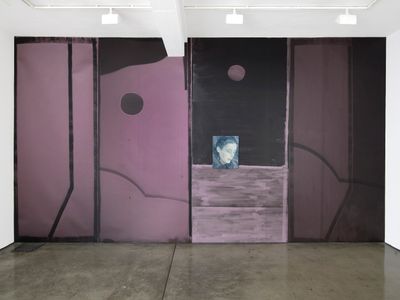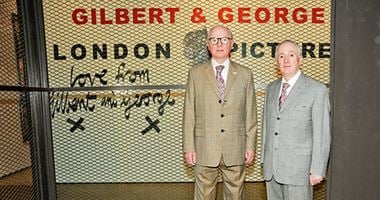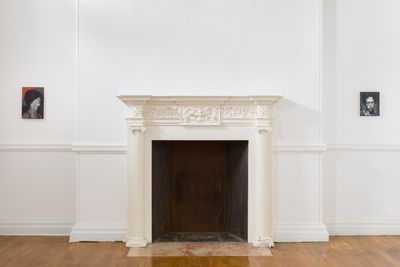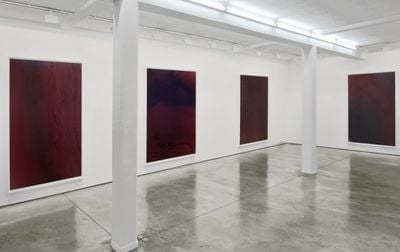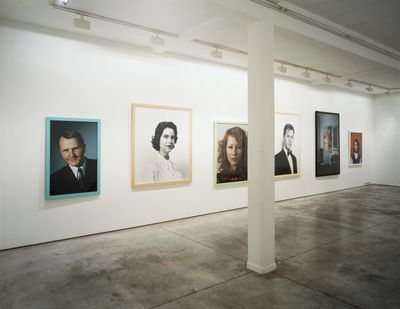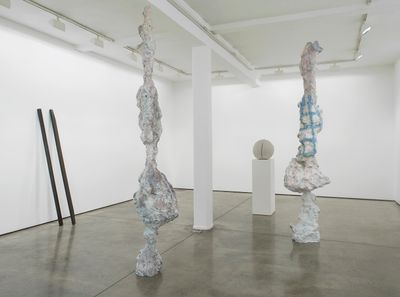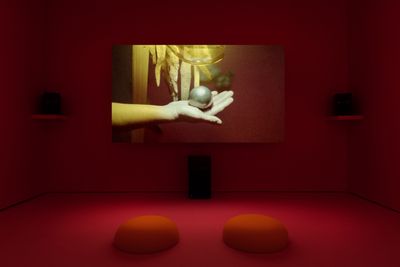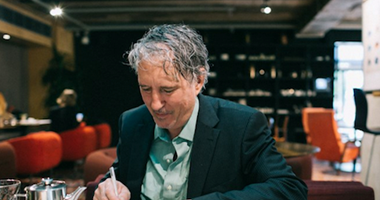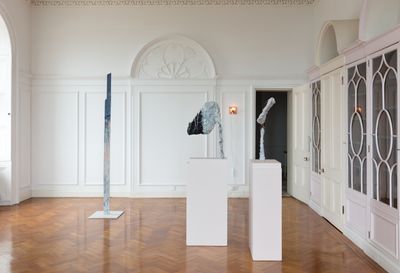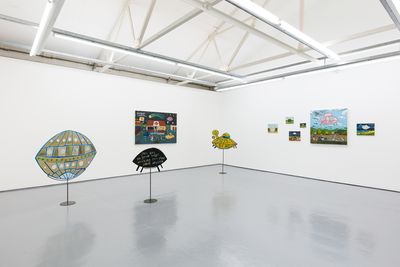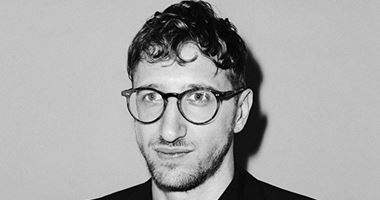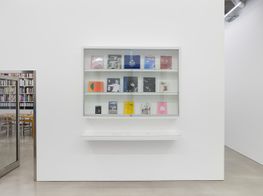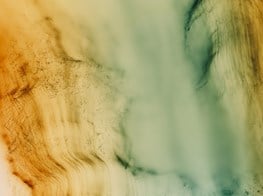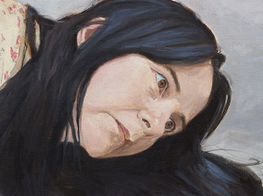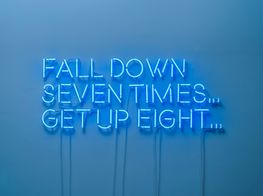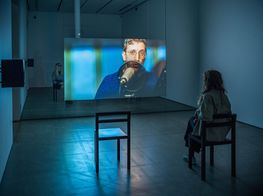Maureen Paley: A Trailblazing Gallerist
Maureen Paley, 2017. Courtesy Maureen Paley. Photo: Devin Blair.

Maureen Paley, 2017. Courtesy Maureen Paley. Photo: Devin Blair.
After moving to London from her native East Coast of the United States, Maureen Paley opened her first gallery in the front room of her Victorian terraced house in 1984.
She gave many international artists, including Mike Kelley, Charles Ray, and Christian Marclay their first exhibitions in London, quickly becoming a leading light for the East End's burgeoning art scene. Since then, and with her own unique style, Paley has helped carve out the careers of some of the most celebrated contemporary artists to have emerged from London. Turner Prize winners Wolfgang Tillmans and Gillian Wearing have shown with Paley for over 25 years and continue to be the subject of major museum exhibitions around the world.
Resistant to expansion abroad and preconceived notions of the 'commercial gallery', Paley has sought to work with a wide range of international male and female artists working in a variety of media. Established artists Rebecca Warren, Liam Gillick, and Michael Krebber are represented alongside the Estates of Peter Hujar and General Idea, whilst younger artists Lawrence Abu Hamdan and Felipe Baeza have recently received critical and institutional acclaim.
In 2017, Paley opened a second space, Morena di Luna, in Hove, where the gallerist has spent weekends and holidays for years. With a newly renovated space on Herald Street in East London opening later this year, she shows no signs of slowing down, instead looking forward to continuing her enthusiasm for showcasing art that is vital to a global audience.
In this conversation, we discuss how Paley's ethos, which emerged from the punk and indie scene and encompasses the cosmos and magic, helped shape a gallery of international renown for the last 35 years.
RMI recall you telling me how you used to all go to The French House in Soho after work, knowing that other dealers, artists, and friends would be there, which is strangely inconceivable now. Looking back, you must view that time fondly and treasure the relationships and conversations that emerged from such a close-knit scene within London. How much has that time and place informed your gallery to this day?
MPI started going to The French House before I had the gallery. I came to London in 1977, and by 1978 had been accepted to the Royal College of Art. I was really intrigued by Soho and by the people who went to The French House, the Coach & Horses, and the Colony Room. Artists like Francis Bacon, Lucian Freud, Derek Jarman, and other bohemian writers and characters.
The idea that you might see them in these locations was always fascinating. You would go to Soho in the late afternoon or early evening and there were different places you would frequent and meet, like Patisserie Valerie or Maison Bertaux, before going to bars later on. People like Martin McGeown, who co-founded Cabinet Gallery, also hung out in places like that. I was able to have significant conversations in this scene.
I feel that supporting people who are near to you creates an ecosystem or conversation of sorts, which I believe is really essential.
Later, once the gallery had formed, I would continue going to those places because we didn't have mobile phones or computers. Dancers, artists, and musicians knew to meet in specific places, because we lacked other ways of getting in touch with one another, which we now take for granted.
I remember seeing Allen Ginsberg one night at The French House, as he was in town for a poetry performance at the Roundhouse. He was standing at the bar with his long-time partner Peter Orlovsky and I was so excited he was there. I remember having the courage to go up to him and he invited me to go to the Roundhouse some days later. It was significant that you could interact with people working across a wide range of media. Things spun out of that in terms of friendships and experiences. Often unlikely connections were made from the diversity of these early encounters.
RMFor decades, your gallery has been a cultural standard-bearer for East London, after you first initiated Interim Art in your own house on Beck Road. The gallery has supported so much that has emerged culturally in this part of London, from artists, students, and suppliers, to bookstores, restaurants, and even through to collectors who you have worked with over so many years, including actors, fashion designers, and musicians.
I really admire that ability to connect with a community beyond the walls of the gallery, and it seems particularly prescient now. How conscious of this have you always been, and do you think this philosophy is becoming harder to sustain?
MPComing out of a punk DIY ethos, I felt inspired to open the gallery as a project space to begin with. That ethos was influenced not only from the galleries that had opened in modest shop fronts in the Lower East Side of New York, but also from John Peel's approach of playing something recorded in a musician's front room that might become a hit on the radio the following week. It came naturally to me, because I was genuinely curious and I then became super committed to the area.
I think that the concept of 'think global act local' is important. Being aware of one's surroundings. When I first came to live in East London, I was really interested in its history—the history of the markets and the way the area had evolved and been neglected, but at the same time was linked to artists like Gilbert and George who had led me there. I remember going to the Market Cafe where they would eat every day—it was run by a brother and sister who were very eccentric. It was such an extraordinary experience to seek out traditional pie and mash shops—and historic pubs... this was all before trendy East London evolved, which is a whole other story.
In the early days of the gallery, I would go to Sweetings in the City, which was full of city gents, and generally you wouldn't see a woman in there—they were all in their pinstripe suits with their brollies. I even staged some dinners in this restaurant before St. John, which I love, existed. I remember them being so surprised that I wanted to use their premises. I was intrigued by the history of the city of London right on my doorstep. I feel that supporting people who are near to you creates an ecosystem or conversation of sorts, which I believe is really essential. I also think that if you do well in what you do, there's something special about sharing and 'putting back in' to benefit those around you.
I would like to believe that we haven't entirely lost our attention spans to social media and there are still people out there willing to gointo further depth.
Right now, in this dark moment, it's very important to recognise that when I started there weren't lots of young galleries that existed. I was pretty much on my own, together with Matt's Gallery, Chisenhale Gallery, and Whitechapel Gallery—there were very few venues that were present around me. When it became a thriving area and the gallery became a meeting place, we were keen to involve other galleries and artists in a collegiate manner.
Wolfgang had his studio above my Herald Street gallery. He was looking for a studio and I found the building. He began by having a studio there before we took over the whole building and he then moved to a larger studio across the street and was always very active in the area. He opened up his own gallery, Between Bridges beneath that studio. Conor Donlon worked for Wolfgang and then opened up his first bookstore on Herald Street before moving to Broadway Market. All of these things were part of the growth of the area in its earliest days.
RMIn recent years, the internet and more specifically social media has had a huge impact on how artists, galleries, and collectors operate. But there is also a concern that these methods, which serve the fast-paced society we now inhabit, threaten to overwhelm art that requires more time from the viewer. Does this worry you, and have you seen a shift in the way people collect?
MPI would like to believe that we haven't entirely lost our attention spans to social media and there are still people out there willing to go into further depth. However, I do see the internet and our ability to research with great speed as closely intertwined.
Some collectors still have nothing to do with social media, and they approach galleries wanting to see works in actual versus virtual spaces. Each period has its own pitfalls and limitations. In the eighties, there was a lot of accelerated buying that was very speculative, and a lot of damage was done. In the seventies, it was much more contemplative. There was no market to speak of and people were engaged in art exploration that I'm still fascinated by. I love Earthworks from that period that extended beyond the actual walls of a gallery space.
I am very interested in the activities of Virginia Dwan, the innovative gallerist who funded Robert Smithson's Spiral Jetty and assisted a number of artists to create Earthworks. She then, after closing her galleries in Los Angeles and New York, went on to create the Dwan Light Sanctuary in Montezuma, New Mexico and lead a much more spiritual life. She shocked everyone when she closed her galleries, but she was hugely influential. Her path was courageous, because in those days people were not collecting to the degree they do today, and her bravery showing important works early on was not always financially rewarded.
That period produced work that demanded time and commitment, and I truly enjoy looking back at it for inspiration. I recently went to the Judd House on Spring Street, and a couple of years ago I went to the Judd and Chinati Foundations in Marfa, Texas. The people who were dedicated to these ideas are essential to me. I still benefit from the illumination it brings to me when I harken back to their fundamental knowledge and awareness.
RMYou are quite a collector of objects and artefacts yourself, as well as art. There is a connection between these objects you surround yourself with, the books you read, the artists you work with, as well as your outlook on life. Ideas relating to the cosmic and magic is central to your way of thinking. Has this been with you for a while? Your parents moved to live in mythical Arizona, so I'm guessing some of it has been gleaned from them?
MPThe idea of the cosmic or the magical was something that I was always drawn to in music and in art. I was very aware of certain spiritual links to works that had been of interest to me. When I was studying, people like John Cage would hold discussions around Zen and philosophical ways of approaching music and art. That was part of how I was taught and how I wished to view things. My knowledge was steeped in that engagement.
Going back again to Judd and his home on Spring Street, you could sense these concerns in the art and objects he chose to live with. I've thought a lot about objects being sacred or imbued with feelings and almost having souls. The concept of animism has informed my sensibility. I am interested in choosing things with meaning and purpose, putting them together in my home as if to create an intuitive installation of sorts.
The idea of the cosmic or the magical was something that I was always drawn to in music and in art.
I have also been moved by a number of different poets, such as Robert Lowell, Kenneth Rexroth, Wallace Stevens, Sylvia Plath, and Ted Hughes to name a few. Hughes was aware of the cosmos and was very shamanic. The idea of the shaman has always interested me.
Recently, I've been thinking about the concept of the wounded healer and Chiron, a term to do with the universal wound that needs to be healed. I think that we are in a moment where we're being called upon to really reflect on how to deal with this, and art can contribute to our fuller understanding of it. When you look at the way art has evolved, how the origins of sculpture can be traced back to standing stones and ancient civilisations, and painting emerged in the caves, this can bring about a greater spiritual understanding of the ways that artistic expression has been with us since the earliest times on earth.
RMWhen you were growing up, was there a specific artwork that had a huge influence on you? One that may have triggered your path into the arts?
MPFrom the age of five, I excelled in drawing at school and had a certain quirky style—I had very long hair that I wore in a long plait, and dressed like I was a ballerina. My father was very interested in ballet, and from a very early age I was looking at Margot Fonteyn dancing with Nureyev. I had a sense of her being very extraordinary. A little later, when I was eight, I studied Russian ballet with Andre Eglevsky, who had danced with Pavlova and Nijinsky, so I was aware of wanting to have this dancer's style like Martha Graham or the operatic presence of Maria Callas.
Art and the idea of bohemian life was something I embraced unconventionally from a young age, when I felt that I didn't quite fit in. Singers and poets such as Bob Dylan and Joan Baez were role models who seemed to be living the life I wanted to lead. From the age of 14, I was going into New York to view and experience things. One of the most striking things happened early on during a school trip when we were taken to the Metropolitan Museum in NY to view the Mona Lisa. You had to queue to see it. When you finally got there, you could only look at it for a second and then you were whisked away.
The idea that da Vinci's hand had touched this painting, and the energy that was coming from it—was completely shocking and that was the beginning of my devotion to art. I also love The Palace at 4 a.m. (1932) by Giacometti, The Red Studio (1911) by Matisse, and The Wounded Deer (1946) by Frida Kahlo, but that early viewing of an almost 'cliché famous' work of art was just so memorable and incredible and life-changing.
RMYou spent a lot of time in New York during your youth, in the heady days of Studio 54 and the punk movement. Do you feel drawn towards outsiders and artists who engage with the fringes of society?
MPI think so. When I graduated from the Royal College of Art in 1980, I had been over to New York in 1979 to visit. I regularly went over there with British friends who were interested in the music scene. We wanted to go to all the clubs and bars.
At that time, SoHo wasn't even a 'place' really; there was very little infrastructure. I went to Studio 54 twice, the Mudd Club, Area, Danceteria, CBGB's, and Nell's. I went to see the The Clash play in NYC as well as London and saw people like Patti Smith perform. There was a lot of activity around gigs and just wandering in the streets and exploring.
Art and the idea of bohemian life was something I embraced unconventionally from a young age, when I felt that I didn't quite fit in.
Working with Peter Hujar, Wolfgang Tillmans, AA Bronson and General Idea plus a huge number of people I have shown over the years, confirms my belief in people existing against the odds. But I would also say that it is motivated by a genuine fascination with their work full stop.
I recently read something that Raymond Pettibon, who I'm a huge fan of, just wrote in one of his 'Answers from Isolation' interviews for the Sadie Coles HQ Instagram site, responding to the current predicament of self-isolating: 'For one thing I have been in isolation my whole life. My life has been books and art, so it seems this doesn't apply to me.' He's really describing the life of the artist. So many artists prefer to spend time in isolation. Someone like Rebecca Warren likes the solitude of the studio and being close to her work without interruption.
RMYou've met some incredible artists very early on in their careers. I often think that people who haven't worked at galleries or with artists don't quite appreciate the depth of the relationship that exists when these partnerships are successful. What is it about this that you find so exciting?
MPWhen you meet someone whose work you are intrigued by, you can never determine how long you are going to know them for. All relationships vary; but I guess one of the things I always wish to establish is a stable relationship with the artists so they feel committed gallery support. It has to be sparked by a true belief in their work, and a kind of admiration or fascination for what they create, as well as who they are.
I often talk about meeting certain artists and being conscious of their aura and what they stand for; but it isn't always motivated by what other people think of them, it is my own judgement. It has been clear to me when I have met several artists, that their work would be very influential. One thing that I have enjoyed about working in the private sector has been continuity with artists, helping them gradually and seeing them evolve over time.
RMIf you cast your mind back to the early days of your relationships with Wolfgang Tillmans, Gillian Wearing, and Rebecca Warren, can you give me a specific work or exhibition by each artist that made you think, 'Wow, this artist is really special'?
MPThe very first show that Wolfgang did at Interim Art on Beck Road in 1993 was quite extraordinary, because he made an installation that didn't look like anything else people had exhibited before. This moment was preceded by people making heavy and large framed works with extreme production values in the 1980s. The fact that his work was put up with scotch magic tape and that it was presented all over the walls and floor space with a lightness of touch was remarkable.
This early Wolfgang Tillmans installation was very unusual and engaging to encounter. I remember thinking he had created his own expression and visual vocabulary. He made something unique to him which has now been much imitated. This was a eureka moment for me.
With Gillian, she invited me to see a show of hers at City Racing gallery in South London, and I found it very interesting. She had already made some of her 'sign works' at this stage. When I met her, I remember thinking she was very astounding and had a great presence. She was quite shy, but she had a strong image. I decided to give her her first show at the gallery after that meeting. She said she wanted to make a set of videos for me, which turned out to include Dancing in Peckham and Confess All On Video (both 1994) and it was the most compact and intense show. This was a real departure after assuming she would present wall-based works. I remember Matthew Slotover coming to see the show and sitting in the gallery watching the videos for at least an hour. People were mesmerised by her work. She threw down the gauntlet from the beginning.
When you meet someone whose work you are intrigued by, you can never determine how long you are going to know them for.
A similar thing happened with Rebecca Warren. I came across her work early on in an exhibition called Material Culture curated by Mike Archer at the Hayward Gallery. In that exhibition she had a work called Every Aspect of Bitch Magic (1996). I wrote her name down in my diary because I loved this vitrine piece. I then I met her in person and put two and two together.
Later on, I went to a show Glenn Brown had curated at The Approach, and as it happens Helmet Crumb (1998) was included in that. I saw this work and thought, I have to speak further to Rebecca. I adored that work immediately. After this Rebecca met me at St. John restaurant and she brought some Polaroids of clay works she had been making and we agreed to exhibit these in 2001. Her first clay exhibition surprised everyone.
RMLet's look forward at some artists you have recently added to your programme...
MPLawrence Abu Hamdan, who we have shown, recently had an exhibition at Chisenhale Gallery just down the road from mine, that helped him win the collective Turner Prize of 2019. Anne Hardy's work has evolved dramatically, resulting in a Winter Commission at Tate Britain. She is making very different work to when I first started showing her.
What is vital to me is what is being produced by the artists now, along with those things we value from the past. I am also always involved in contributing to our artist's exhibitions in the public sector that are forthcoming. We have recently added artists like Felipe Baeza, Eduardo Sarabia, and Paulo Nimer Pjota to our programme.
RMWhat music are you listening to and what are you reading at the moment during this period of isolation in Hove?
MPI'm listening to Kurt Vile's album Bottle It In, MTV Unplugged in New York by Nirvana, Eden's Island by Ede Albaz, which was introduced to me by Anne Hardy, Lie Down in the Light by Bonnie Prince Billie, Mi Sueño by Ibrahim Ferrer, The White Album by The Beatles, A Bath Full of Ecstasy by Hot Chip, Kind of Blue by Miles Davis, and Inspiration Information by Shuggy Otis.
As for what I'm reading, Alastair Mackinven gave me a great book about Sun Ra called Omniverse, and I'm also reading Olivia Laing's new book, Funny Weather; Donald Judd Spaces: Judd Foundation New York & Texas by Donald Judd, to remind me of Marfa; The Happy Prince by Oscar Wilde, and The Book of Miracles, a reproduction of the 16th-century German manuscript published by Taschen.—[O]


